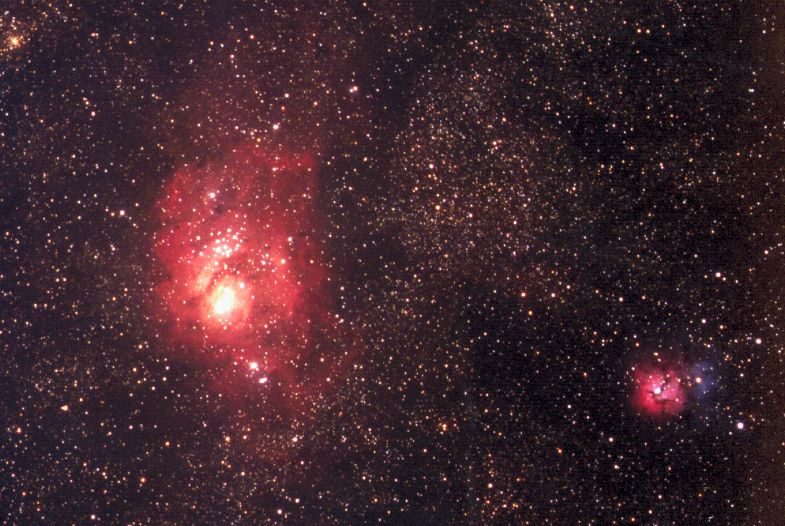
This is a photo of prominent nebula in Sagittarius taken on April 15, 1999. The summer Milky Way cuts through Sagittarius in a region of the sky filled with beautiful star clusters and bright nebula. This is a favorite part of the sky for me.
The Lagoon Nebula is the large red nebula in the left center. It is about 2,500 light-years away from our solar system. This cloud of gas and dust covers a region of space about 30 light-years by 65 light-years. New stars formed by condensing clouds of gas shine in the center of the nebula. The radiation from these stars excites the hydrogen gas in the nebula, causing it to glow red. The nebula can be seen with the naked eye on a clear night under dark skies as a fuzzy grey patch near the main band of the Milky Way in Sagittarius. The light is, unfortunately, too faint for you to see color with the naked eye. The discovery of the Lagoon Nebula is generally attributed to French astronomer Le Gentil in 1747, but it may have actually been seen first by British astronomer John Flamsteed in 1680. This nebula got its name from a dark swath that crosses it on one side.
The Trifid Nebula is the smaller red and blue nebula on the right. It is about 2,500 light-years away from us, and is about 20 light-years across. The Trifid Nebula is about the same distance from us as the Lagoon Nebula. The Trifid Nebula is so named because it is divided into three regions. The red color comes from clouds of gas illuminated by one or more stars in the center of the nebula that excite the gas and cause emission radiation of the gas. The blue color is simply a reflection of star light from gas clouds that are not close enough to the stars to be heated like the red colored clouds, and thus do not produce emission radiation. The contrast between the emission nebula clouds and the reflection nebula clouds is a beautiful feature of the Trifid Nebula. The Trifid Nebula was probably first discovered by French astronomer Le Gentil in 1747. It is believed that it was first named the "Trifid Nebula" by John Herschel, the son of the famous astronomer William Herschel, in the mid-1800's. Both objects were included in the first list published by Charles Messier.
The photo was taken at prime focus with a Takahashi Epsilon 250 telescope at f3.4. The film was Kodak Pro 100 medium format 220 film. This is a 30 minute guided exposure using an SBIG ST-4 autoguider mounted on a Takahashi FS-78 refractor.
M8 (NGC 6523)
Constellation: Sagittarius
RA: 18h 03m 48s Dec: -24d 23' 00" (J2000)
M20 (NGC 6514)
Constellation: Sagittarius
RA: 18h 02m 18s Dec: -23d 02' 00" (J2000)
April 15, 1999
Photo by Sid Leach
Iola, Texas
Recent Images.
Complete list of images.
Description of equipment used to acquire images.
Home
Feedback and comments should go to Sid